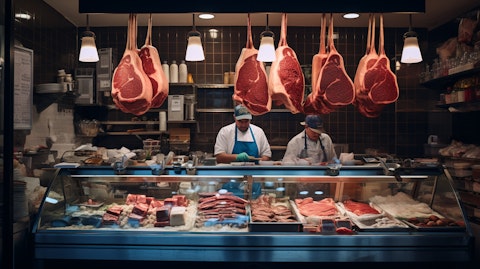In this article, we discuss the 20 most food insecure states in the US. If you want to read about other most food insecure states in the US, go directly to 5 Most Food Insecure States in the US.
In 2022, food insecurity remained a pressing concern across the United States, affecting approximately 12.8 percent of households. This distressing statistic indicates that a significant portion of the population faced challenges in providing enough food for all household members due to limited resources. The issue of food insecurity highlights the persistent struggle that many Americans endure in accessing an adequate and consistent food supply, which is essential for maintaining health and well-being.
To address the problem of food insecurity, federal spending on the United States Department of Agriculture’s (USDA) food and nutrition assistance programs totalled $183.0 billion in fiscal year 2022. While this allocation represents a substantial investment in combating hunger, it is noteworthy that this figure reflects a 6 percent decrease from the previous year when adjusted for inflation. Despite the substantial funding directed towards food assistance programs, the prevalence of hunger in the United States continued to rise. According to USDA data, 10.8 percent of American households experienced hunger in 2023, marking an increase from 10.4 percent in 2021.
Against this backdrop, it becomes increasingly imperative to delve deeper into the specific regions within the country where food insecurity is most acute. By examining the 20 most food insecure states in the US, we can gain valuable insights into the localized factors contributing to this pressing issue. Understanding the unique challenges faced by these states, such as economic disparities, limited access to affordable and nutritious food, and barriers to food assistance programs, is crucial for developing targeted interventions and policies to address food insecurity effectively.
Through comprehensive analysis and concerted efforts, we can work towards creating a more equitable food system that ensures all individuals and families have access to sufficient and nutritious food. By shedding light on the 20 most food insecure states in the US, we can initiate meaningful dialogue, raise awareness, and drive action to address this critical issue and strive towards a future where hunger is eradicated for all Americans. So many companies have been taking initiatives to combat this problem below are a few that have made their mark in this struggle.
General Mills (NYSE:GIS)
General Mills (NYSE:GIS) plays a pivotal role in combating hunger and food waste through various initiatives. As a founding partner of Feeding America, the Global Food Banking Network, and Partners in Food Solutions, the company has facilitated over 201 million meals globally since 2010 through food donations. Additionally, General Mills has partnered with MealConnect to recover and distribute more than 575 million pounds of surplus food in collaboration with 90 food banks. This effort has involved over 1.2 million food pickups and supported over 4,200 non-profit hunger relief organizations since 2014.
Furthermore, the company sponsors the annual Feeding Better Futures Scholars Program, engaging young innovators across North America to propose solutions addressing hunger relief, food waste, and sustainable agriculture. Through these endeavours, General Mills (NYSE:GIS) demonstrates its commitment to making a positive impact on food security and sustainability.
Nestle (OTC:NSRGY)
Nestlé’s (Other OTC:NSRGY) annual ‘day of service’ initiative, Nestlé Cares, unites its eight operating companies across 47 US states in over 150 events. The company’s 25-year partnership with Feeding America has resulted in over 100 million pounds of food and water donations to support more than 185 food banks, including those aiding hurricane-affected communities. Nestlé (Other OTC:NSRGY) also collaborates with SAVE FOOD to prevent food loss, focusing on responsible sourcing and consumer education, alongside efforts to establish a global standard for measuring food waste in collaboration with the World Resources Institute.
PepsiCo (NASDAQ:PEP)
PepsiCo (NASDAQ:PEP) is a partner of the UN’s World Food Program (WFP), committed to combating global hunger by providing food aid to developing nations. Through this partnership, WFP has supported over 90 million people in need. In a notable initiative, PepsiCo (NASDAQ:PEP) Foundation, the company’s philanthropic arm, invested $3.5 million in a public-private partnership with WFP and the US Agency for International Development (USAID). This investment aims to develop a food product made from chickpeas to address malnutrition in Ethiopia.

A butcher shop showcasing fresh meats and seafood for customers.
Methodology
The list of the 20 most food insecure states in the US is based on data provided by the United States Department of Agriculture (USDA), on food insecurity in the United States. For reporting purposes, the USDA classifies households into two categories based on their level of food security. Those with high or marginal food security are considered food secure, while those experiencing low or very low food security are categorized as food insecure. This classification is determined by the household’s responses to a series of questions regarding behaviours and experiences related to difficulty in meeting food needs. These questions assess a wide range of severity levels of food insecurity, allowing for a nuanced understanding of the challenges faced by households in accessing an adequate and consistent food supply. The higher the percentage, the higher the food insecurity in that state.
In cases where states share the same percentage of food insecure households, the ranking is determined by the total number of households. States with a greater total number of households, and consequently a higher count of food insecure households, are placed higher on the list. So, using this approach, we have listed down the 20 most food insecure states in the US.
By the way, Insider Monkey is an investing website that tracks the movements of corporate insiders and hedge funds. By using a similar consensus approach, we identify the best stock picks of more than 900 hedge funds investing in US stocks. The top 10 consensus stock picks of hedge funds outperformed the S&P 500 Index by more than 140 percentage points over the last 10 years (see the details here). Whether you are a beginner investor or professional one looking for the best stocks to buy, you can benefit from the wisdom of hedge funds and corporate insiders.
20. Georgia
Percentage of Food Insecure Households: 11.3%
Starting our list of 20 most food insecure states in the US with Georgia. In Georgia, 1,156,660 people, including 335,720 children, face hunger, requiring an additional $720,132,000 annually to meet their food needs. Charitable programs alone can’t fill this gap. SNAP provides crucial temporary assistance, supplementing funds for food purchases until individuals can regain stability. Collaborative efforts between charities and government programs like SNAP are vital to address food insecurity effectively in Georgia.
19. New York
Percentage of Food Insecure Households: 11.3%
As pandemic-era food assistance programs come to an end, New York is witnessing a troubling surge in food insecurity. The convergence of factors such as escalating living expenses, job instability, and displacement has contributed to the plight of nearly 2 million hungry New Yorkers, among whom 596,060 are children. Against the backdrop of an ongoing migrant crisis, advocates and experts have been vocal about the urgency of addressing this growing food epidemic. Finding sustainable solutions to alleviate the crisis has become paramount for the state as it navigates these complex challenges.
18. Wyoming
Percentage of Food Insecure Households: 11.4%
Food insecurity in Wyoming is a pressing issue, with 86,000 residents, as reported by First Lady Jennie Gordon’s Wyoming Hunger Initiative, struggling to access adequate food. Natrona County School District 1 highlights the severity, with 28% of enrolled students facing food insecurity. Economic and geographical factors unique to the state contribute to this ongoing problem. Both government and private initiatives strive to address the needs of individuals and families unable to afford quality food through a variety of programs, forming a patchwork of support aimed at targeted recipients.
17. Florida
Percentage of Food Insecure Households: 11.4%
After nearly a decade of decline, Florida is experiencing a concerning increase in food-insecure households, slightly surpassing the national average over the same period. According to data from Feeding America, approximately 3,315,500 Florida residents are currently suffering from food insecurity. Gadsden and Leon counties emerge as the state’s most food-insecure areas.
16. Delaware
Percentage of Food Insecure Households: 11.5%
Delaware ranks sixteenth on our list of 20 most food insecure states in the US. According to Feeding America’s Map the Meal Gap study for 2020, the state of Delaware saw 93,900 individuals experiencing hunger, with 30,920 of them being children. These figures highlight the persistent challenge of food insecurity faced by vulnerable populations within the state, underscoring the need for continued efforts to address this pressing issue and ensure access to nutritious food for all residents, especially children.
15. Tennessee
Percentage of Food Insecure Households: 11.5%
In Tennessee, the sobering statistics reveal a significant challenge with hunger, affecting a staggering 800,970 individuals. Among them, 197,490 are children, highlighting a distressing reality where approximately 1 in 8 children faces hunger. The collective need to bridge the gap for these individuals amounts to an estimated $499,905,000 annually to ensure their basic food requirements are met. These figures underscore the pressing need for concerted efforts to address food insecurity in the state, particularly for its most vulnerable populations.
14. Ohio
Percentage of Food Insecure Households: 11.5%
Ohio grapples with one of the highest rates of food insecurity nationwide, reflecting a deeply concerning trend. Shockingly, 1,391,290 individuals in Ohio experience food insecurity, with 386,430 of them being children. The collective need among these individuals for an additional $835,411,000 annually to fulfill their food requirements underscores the severity of the issue. Alarmingly, 1 in 7 Ohio children resides in households struggling with food insecurity, highlighting the significant impact on the state’s youth.
13. Nevada
Percentage of Food Insecure Households: 11.7%
In Nevada, the struggle with hunger impacts 409,540 individuals, with 129,350 of them being children. Shockingly, 1 in 5 children in the state faces hunger, highlighting the severity of the issue among its youth. The collective need among these individuals for an additional $253,036,000 annually to address their food needs underscores the magnitude of the problem. These statistics emphasize the urgent need for comprehensive efforts and support systems to combat food insecurity in Nevada, particularly for its vulnerable populations, including children.
12. Michigan
Percentage of Food Insecure Households: 11.9%
According to the latest federal data, food insecurity in Michigan is on the rise, slightly surpassing the national average. Between 2020 and 2022, an average of 11.9% of Michigan households experienced food shortages due to financial constraints, as reported by the U.S. Department of Agriculture. In 2020 alone, 1.15 million Michiganders faced challenges in accessing adequate food, with nearly 300,000 of them being children. This translates to approximately one in nine Michiganders experiencing food insecurity, highlighting the significant impact of this issue on the state’s population.
11. Nebraska
Percentage of Food Insecure Households: 12.1%
In Nebraska, an alarming 13.5% of children grapple with food insecurity, signifying a pressing issue that severely affects their well-being. The scarcity of consistent access to nutritious meals is hindering children’s potential to thrive, with far-reaching consequences for their health. Beyond fostering social and behavioural challenges, there’s a significant correlation between hunger and chronic ailments like high blood pressure, heart disease, and diabetes. These conditions not only pose immediate health risks but also have enduring effects on children’s mental, emotional, and physical well-being, underscoring the urgency of addressing food insecurity in Nebraska to safeguard the health of its youngest residents.
10. Missouri
Percentage of Food Insecure Households: 12.2%
In Missouri, the issue of hunger is deeply concerning, with 715,170 individuals struggling to access sufficient food. Among them, 177,320 are children, highlighting the vulnerability of the state’s youth to food insecurity. The collective need for an additional $436,393,000 annually to meet the food requirements of these individuals emphasizes the scale of the problem. Addressing food insecurity in Missouri requires concerted efforts and comprehensive strategies to ensure that all residents have access to nutritious food and the opportunity to lead healthy and fulfilling lives.
9. Alabama
Percentage of Food Insecure Households: 12.4%
In central Alabama, the challenge of food insecurity extends beyond those who qualify for Federal Nutrition Assistance, encompassing a broader spectrum of residents. Even individuals eligible for federal aid may still encounter regular struggles to access adequate food. In response to this widespread need, the Community Food Bank and its network of partners serve as vital resources for assistance and support, providing a crucial lifeline for those facing hunger in the region.
8. Kentucky
Percentage of Food Insecure Households: 13.1%
Kentucky grapples with a higher percentage of food-insecure households than the national average, standing at 13.1 percent. However, this rate varies significantly across counties. In 17 of the most-impacted Kentucky counties, more than 1 in 5 people reside in food-insecure households, highlighting the localized nature of the issue and the varying degrees of need within the state.
7. West Virginia
Percentage of Food Insecure Households: 14.2%
In West Virginia, both food insecurity and obesity are prevalent concerns. The state faces higher rates of food insecurity compared to the national average, with a significant portion of residents depending on government assistance, such as SNAP benefits, to afford sufficient food. This reliance on assistance programs underscores the widespread need for support in accessing nutritious meals, highlighting the complex interplay between food insecurity and health outcomes like obesity within the state.
6. Oklahoma
Percentage of Food Insecure Households: 14.3%
Sixth on the list of 20 most food insecure states in the US is Oklahoma. Nearly a quarter of a million Oklahoma households, encountered food insecurity between 2020 and 2022. Chris Bernard, president and CEO of Hunger Free Oklahoma, attributes this rise in food insecurity to the cessation of pandemic-era food programs, alongside inflation and increasing household expenses. Bernard emphasizes the critical role of food assistance programs, such as an expanded Supplemental Nutrition Assistance Program (SNAP) and free school meals, in providing a safety net for individuals and families experiencing food insecurity.
Click to continue reading and find out about 5 Most Food Insecure States in the US.
Suggested Articles:
- 20 Fast Food Chains with the Most Locations in the World
- 20 Most Expensive Foods In The World
- 20 States With The Highest Fast Food Consumption In The US
Disclosure: None. 20 Most Food Insecure States in the US is originally published on Insider Monkey.





